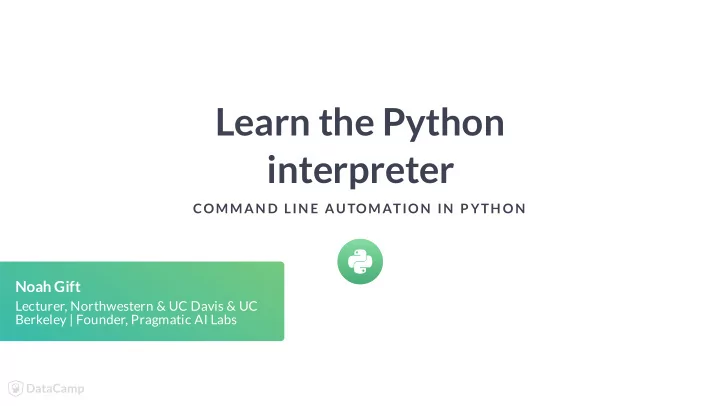

Learn the Python interpreter COMMAN D LIN E AUTOMATION IN P YTH ON Noah Gift Lecturer, Northwestern & UC Davis & UC Berkeley | Founder, Pragmatic AI Labs
Three Laws of Automation 1. Any task that is talked about being automated, will eventually be automated 2. If it isn't automated it is broken 3. If a human is doing it, a machine eventually will do it better COMMAND LINE AUTOMATION IN PYTHON
Major Learning Objectives IPython shell commands Shell commands with subprocess Walking the �le system Command-line functions COMMAND LINE AUTOMATION IN PYTHON
Using IPython with shell commands The ! syntax executes shell commands # Show free disk !df -h Filesystem Size Used Avail Use% Mounted on overlay 335G 176G 159G 53% / tmpfs 64M 0 64M 0% /dev tmpfs 7.7G 0 7.7G 0% /sys/fs/cgroup /dev/nvme0n1p1 335G 176G 159G 53% /etc/hosts COMMAND LINE AUTOMATION IN PYTHON
Capturing output from IPython shell commands Output of command can be assigned to a variable ls = !ls The type is an SList type(ls) IPython.utils.text.SList COMMAND LINE AUTOMATION IN PYTHON
Pure Python vs IPython The ! character will throw a syntax error in Python ? ~ python foo.py File "foo.py", line 1 !ls ^ SyntaxError: invalid syntax The subprocess module can perform equivalent actions COMMAND LINE AUTOMATION IN PYTHON
Passing programs to the Python interpreter Two ways to execute Python code to an interpreter Passing a script to the Python interpreter python hello.py Passing a program to the Python interpreter via -c python -c "import datetime;print(datetime.datetime.utcnow())" 2019-04-01 01:04:47.17224 COMMAND LINE AUTOMATION IN PYTHON
Practicing with the IPython shell COMMAN D LIN E AUTOMATION IN P YTH ON
Capture IPython Shell output COMMAN D LIN E AUTOMATION IN P YTH ON Noah Gift Lecturer, Northwestern & UC Davis & UC Berkeley | Founder, Pragmatic AI Labs
Unix Pipes Unix Philosophy Simple T ools Combine for Sophisticated Solutions COMMAND LINE AUTOMATION IN PYTHON
Understand Unix Pipes Using Unix Pipes to count the size of python �les # Sum them up using `awk` ls -l | awk '{ SUM+=$5} END {print SUM}' 8040 # Pipe multiple outputs using Pipe operators ls -l | grep .py | awk '{ SUM+=$5} END {print SUM}' 3776 COMMAND LINE AUTOMATION IN PYTHON
Capturing shell output with bash magic function Magic function %%bash --output %%bash --out output ls -l | awk '{ SUM+=$5} END {print SUM} The type of this command is a string type(output) `str` output COMMAND LINE AUTOMATION IN PYTHON
Capturing shell output with ! Syntax Alternate method of invoking shell commands The ! operator invokes shell commands in IPython ls_count = !ls -l | awk '{ SUM+=$5} END {print SUM}' The type of this command is an SList type(ls_count) IPython.utils.text.SList ls_count ['8070'] COMMAND LINE AUTOMATION IN PYTHON
Bash and STDERR This is a command that will create output to STDERR %%bash --out output ls --turbo STDERR isn't captured COMMAND LINE AUTOMATION IN PYTHON
Capture both STDOUT and STDERR %%magic allows STDOUT and STDERR capture %%bash --out output --err error ls -l | awk '{ SUM+=$5} END {print SUM}' echo "no error so far" >&2 The output of error error 'no error so far\n' COMMAND LINE AUTOMATION IN PYTHON
Practicing with the Captured Output COMMAN D LIN E AUTOMATION IN P YTH ON
Automate with SList COMMAN D LIN E AUTOMATION IN P YTH ON Noah Gift Lecturer, Northwestern & UC Davis & UC Berkeley | Founder, Pragmatic AI Labs
SList methods Three main methods fields grep sort COMMAND LINE AUTOMATION IN PYTHON
Using SList �elds List the items in a directory and save the variable ls = !ls -l /usr/bin Collect whitespace-separated �elds ls.fields(1,5)[1:4] ['1 Jan', '1 Jul', '1 Sep'] COMMAND LINE AUTOMATION IN PYTHON
Using SList grep Assign ls output to an SList ls = !ls -l /usr/bin Grep a pattern ls.grep("kill") Only results matching pattern are displayed ['lrwxrwxrwx 1 root root 5 May 14 2018 pkill -> pgrep', '-rwxr-xr-x 1 root root 26704 May 14 2018 skill'] COMMAND LINE AUTOMATION IN PYTHON
Using SList sort Capture df unix command disk_usage = !df -h Sort by usage disk_usage.sort(5, nums = True) ['/dev/nvme0n1p1 335G 177G 158G 53% /etc/hosts', 'Filesystem Size Used Avail Use% Mounted on', 'overlay 335G 177G 158G 53% /', 'shm 64M 24K 64M 1% /dev/shm'] COMMAND LINE AUTOMATION IN PYTHON
SList and regular Python lists An SList can be popped using .pop() var = ls.pop() print(var) 'pear84.txt' slicing operations work on SLists ls[-4:] ['pear5.txt', 'pear52.txt', 'pear56.txt', 'pear6.txt'] COMMAND LINE AUTOMATION IN PYTHON
Wrapping up SList SList to list work�ow type(ls) 'IPython.utils.text.SList' newls = list(ls) 'list' SList to set sls = set(ls) SList to dictionary dls = dict(vals=ls) COMMAND LINE AUTOMATION IN PYTHON
Practicing with SList COMMAN D LIN E AUTOMATION IN P YTH ON
Recommend
More recommend